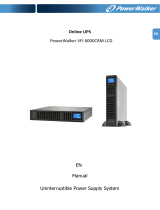
16
0.99 @ nominal voltage (input voltage)
Output voltage 208/220/230/240VAC
ECO Mode Voltage
[1]
Adjustable ±10% or ±15%
Frequency Range
(Synchronized Mode)
Adjustable 1-10% (default ±8%)
Outside of the range, it switches to converter mode
Frequency Range (Batt.
Mode)
50/60 Hz ± 0.5 Hz
Overload
Line Mode: warning @ 100-110%; bypass after 60s @ 110-120%;
bypass immediately @ >120%
Battery Mode: warning @ 100-110%; shutdown after 10s @ 110-
120%; shutdown immediately @ > 120%
< 3 % THD (linear load); < 5 % THD (non-linear load)
Energy saving technology. ECO mode over 95%
Protection
UPS output cut off immediately or input fuse.
Surge protection IEC 61000-4-5 level 4
4 hours recover to 90% capacity (Typical)
Battery Pack Connector available
[5]
Dimension, W x H x D
(mm)
20-90 % RH @ 0- 40°C (non-condensing)
Supports Windows®, Linux, Unix, macOS and HID support for USB
PowerMaster available at powermaster.powerwalker.com
Power management from SNMP manager and web browser
[1] ECO Mode offers higher efficiency in line mode, but transfer time is not guaranteed to be
0ms.
[2] When bypass is disabled, the UPS will not turn on to bypass in case of overload or fault.
[3] The load capacity will be derated to 60%.
ECO Mode, Bypass Mode are disabled (regardless
of the settings)
[4]If ROO (Remote On/Off) is enabled, UPS can be turned on/off by the ROO port (opened
circuit turns off; closed circuit turns on). EPO (Emergency Power Off) only turns off the UPS’
output. After closing the circuit UPS needs to be manually turned on.
[5] UPS cannot detect the number of Battery Packs, so this setting is essential. If BP is 1-3, the
charger current is increased to 4A.









